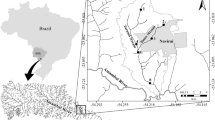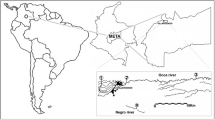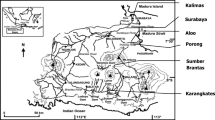Abstract
The Araguari River, one of the most important waterways in the Brazilian state of Amapá, is ecologically relevant and essential for the conservation of Amazonian fish biodiversity. Our previous studies demonstrated contamination of water and fish by metals. In particular, water samples showed genotoxic damage in Danio rerio. Here, we extended our studies of potential genotoxic damage to native fish from sampling sites located in the Araguari River lower section. To accomplish this, we collected samples of fish with different feeding behaviors, but in the same sampling sites, and evaluated the same genotoxicity biomarkers in erythrocytes. All eleven species of fish collected in the Araguari River lower section showed profiles and frequencies of genotoxic damage similar to those previously observed in tests with D. rerio, confirming that genotoxic pollutants present in these waters are also causing damage to native fish species.


Similar content being viewed by others
References
Brasil (2005) Conselho Nacional do Meio Ambiente (CONAMA) - Resolução no 357 de 17 março de 2005. http://www2.mma.gov.br/port/conama/legiabre.cfm?codlegi=459. Accessed date January 16 2023
Da Silva CM, Viana LF, Lima Cardoso CA, Gonar Silva Isacksson ED, Silva JC, Florentino AC (2022) Landscape composition and inorganic contaminants in water and muscle tissue of Plagioscion squamosissimus in the Araguari River (Amazon, Brazil). Environ Res. https://doi.org/10.1016/j.envres.2022.112691
Dagosta FCP, Pinna M (2019) The fishes of the Amazon: distribution and biogeographical patterns, with a comprehensive list of species. Bull Am Mus Nat Hist 431:5–163. https://doi.org/10.1206/0003-0090.431.1.1
Dalzochio T, Rodrigues GZP, Simões LAR, de Souza MS, Petry IE, Andriguetti NB, Silva GJH, da Silva LB, Gehlen G (2018) In situ monitoring of the Sinos River, southern Brazil: water quality parameters, biomarkers, and metal bioaccumulation in fish. Environ Sci Pollut Res 25:9485–9500. https://doi.org/10.1007/s11356-018-1244-7
Dalzochio T, Andriguetti NB, Simões LAR, Gehlen G, da Silva LB (2019) Genotoxicity biomarkers in fish erythrocytes and water quality parameters. In: Gómez-Oliván L (eds) Pollution of water bodies in Latin America. Springer, Cham. https://doi.org/10.1007/978-3-030-27296-8_15
Calado SLM, Santos GS, Vicentini M, Bozza DC, Prodocimo V, Magalhães VF, Cestari MM, De Silva De Assis HC (2020) Multiple biomarkers response in a neotropical fish exposed to paralytic shellfish toxins (PSTs). Chemosphere. (238):124612. https://doi.org/10.1016/j.chemosphere.2019.124616
De Jesus IS, Cestari MM, Bezerra MA, Affonso PRAM (2016) Genotoxicity effects in freshwater fish from a brazilian impacted river. Bull Environ Contam Toxicol 96:490–495. https://doi.org/10.1007/s00128-016-1755-1
Dos Santos SL, Viana LF, Merey FM, Crispim BA, Solorzano JC, Barufatti A, Cardoso CAL, Lima-Junior SE (2020) Evaluation of the water quality in a conservation unit in Central-West Brazil: metals concentrations and genotoxicity in situ. Chemosphere. (251):126365. https://doi.org/10.1016/j.chemosphere.2020.126365
Ghisi NC, de Oliveira EC, Fávaro LF, de Assis HCS, Prioli AJ (2014) In situ assessment of a neotropical fish to evaluate pollution in a river receiving agricultural and urban wastewater. Bull Environ Contam Toxicol 93:699–709. https://doi.org/10.1007/s00128-014-1403-6
Hacon SS, Oliveira-da-Costa M, Gama CS, Ferreira R, Basta PC, Schramm A, Yokota D (2020) Mercury exposure through fish consumption in traditional communities in the brazilian Northern Amazon. Int J Environ Res Public Health 17:5269. https://doi.org/10.3390/ijerph17155269
Lacerda D, Vergilio CS, da Silva ST, Viana Costa LH, Rangel TP, Vaz de Oliveira BC, Ribeiro de Almeida DQ, Pestana IA, Gomes de Almeida M, de Rezende CE (2020) Comparative metal accumulation and toxicogenetic damage induction in three neotropical fish species with distinct foraging habits and feeding preferences. Ecotoxicol Environ Saf. (195):110499. https://doi.org/10.1016/j.ecoenv.2020.110449
Li D, Pan B, Wang Y, Han X, Lu Y (2023) Bioaccumulation and health risks of multiple trace metals in fish species from the heavily sediment-laden Yellow River. Mar Pollt. (188):114664. https://doi.org/10.1016/j.marpolbul.2023.114664
Nersesyan A, Muradyan R, Kundi M, Fenech M, Bolognesi C, Knasmueller S (2020) Smoking causes induction of micronuclei and other nuclear anomalies in cervical cells. Int J Hyg Environ Health. (266):113492. https://doi.org/10.1016/j.ijheh.2020.113492
R Development Core Team (2020) R: a language and environment for statistical computing. R Foundation for Statistical Computing, Vienna. http://. R-project.org.
Rico A, de Oliveira R, de Souza S, Nunes G, Rizzi C, Villa S, de Caroli VB, Montagner CC, Waichman AV (2022) Ecological risk assessment of pesticides in urban streams of the Brazilian Amazon. Chemosphere. (291):132821. https://doi.org/10.1016/j.chemosphere.2021.132821
Riveros AF, Jut Solórzano JC, Monaco IA, Lima Cardoso CA, Súarez YR, Viana LF (2021) Toxicogenetic effects on fish species in two sub-basins of the Upper Paraguay River, Southern Pantanal - Brazil. Chemosphere. https://doi.org/10.1016/j.chemosphere.2020.128383
Santos ES, Cunha AC (2015) Análise de cenários hidrossedimentométricos para estimar taxas de assoreamento e vida útil do reservatório da UHE Cachoeira Caldeirão no Rio Araguari/AP-Brasil. Biota Amaz 5:88–97. https://doi.org/10.18561/2179-5746/biotaamazonia.v5n3p88-97
Santos GM, Mérona B, Juras AA, Jégu M (2004) Peixes do Baixo Rio Tocantins: 20 anos depois da Usina Hidrelétrica Tucuruí. Eletronorte, Brasília
Sleen PV, Albert JS (2018) Field guide to the fishes of the Amazon, Orinoco, and Guianas. Princeton University Press, Publisher
Viana LF, Súarez YR, Cardoso CAL, Crispim BA, Cavalcante DNC, Grisolia AB, Lima-Junior SE (2018) The response of neotropical fish species (Brazil) on the water pollution: metal bioaccumulation and genotoxicity. Arch Environ Contam Toxicol 75:476–485. https://doi.org/10.1007/s00244-018-0551-9
Viana LF, Cardoso CAL, Lima-Junior SE, Súarez YR, Florentino AC (2020) Bioaccumulation of metal in liver tissue of fish in response to water toxicity of the Araguari-Amazon River, Brazil . Environ Monit Assess 192:781. https://doi.org/10.1007/s10661-020-08696-2
Viana LF, Kummrow F, Cardoso CAL, de Lima NA, Solórzano JCJ, Crispim BA, Barufatti A, Florentino AC (2021) High concentrations of metals in the waters from Araguari River lower section (Amazon biome): relationship with land use and cover, ecotoxicological effects and risks to aquatic biota. Chemosphere. (285):131451. https://doi.org/10.1016/j.chemosphere.2021.131451
Viana LF, Kummrow F, Cardoso CAL, de Lima NA, Crispim BA, Barufatti A, Florentino AC (2023a) Metal bioaccumulation in fish from the Araguari River (Amazon biome) and human health risks from fish consumption. Environ Sci Pollut Res 30:4111–4122. https://doi.org/10.1007/s11356-022-22457-3
Viana LF, de Souza DCD, da Silva EB, Kummrow F, Cardoso CAL, de Lima NA, Crispim BA, Barufatti A, Florentino AC (2023b) Bioaccumulation of metals and genotoxic effects in females of Colomesus asellus collected in an Amazon River estuary, Amapá, Brazil. Limnetica. https://doi.org/10.23818/limn.42.15
Acknowledgements
We thank the Fundação de Amparo à Pesquisa do Amapá-FAPEAP (Process 250.2303.123/2018), ICMBio (license 63366-1), Conselho Nacional de Desenvolvimento Científico e Tecnológico, Brazil (CNPq; process number 429400/2016–0 and 311975/2018–6), Programa de Desenvolvimento de Pós-Graduação (PDPG/Amazônia Legal/CAPES, Brazil, process no. 88881.510191/2020–01) and the Coordenação de Aperfeiçoamento de Pessoal de Nível Superior-CAPES/FAPEAP for the scholarship awarded to the first author.
Author information
Authors and Affiliations
Contributions
VLF: original draft preparation, conceptualization, writing and data analysis. KF: review, writing, and editing. LNA: reading of slides and writing. CBA: review, writing, and editing. BA: review, writing, and editing. FAC: review, writing, and editing.
Corresponding author
Ethics declarations
Conflict of interest
The authors declare that they have no conflict of interest.
Ethics Approval
This project was approved by the Ethics Committee on the Use of Animals of the Federal University of Amapá (UNIFAP—017/2019).
Additional information
Publisher's Note
Springer Nature remains neutral with regard to jurisdictional claims in published maps and institutional affiliations.
Rights and permissions
Springer Nature or its licensor (e.g. a society or other partner) holds exclusive rights to this article under a publishing agreement with the author(s) or other rightsholder(s); author self-archiving of the accepted manuscript version of this article is solely governed by the terms of such publishing agreement and applicable law.
About this article
Cite this article
Viana, L.F., Kummrow, F., de Lima, N.A. et al. Genotoxicity biomarkers on native fish species from the Araguari River (Amazon biome). Bull Environ Contam Toxicol 110, 76 (2023). https://doi.org/10.1007/s00128-023-03713-9
Received:
Accepted:
Published:
DOI: https://doi.org/10.1007/s00128-023-03713-9




